HI6006 Competitive Strategy Analysis: Retail Industry Report
VerifiedAdded on 2022/11/24
|13
|2901
|419
Report
AI Summary
This report analyzes the competitive strategies within the Australian retail industry, focusing on major players like Woolworths and Coles. The report summarizes a case study examining the competitive landscape, the impact of Aldi's entry, and the strategic issues faced by these organizations. It identifies key strategic issues, such as price wars and the challenges posed by global retailers. Porter's Five Forces framework is applied to analyze the industry's competitiveness, evaluating the bargaining power of buyers and suppliers, threats of new entrants and substitutes, and rivalry among firms. The report further analyzes the business strategies of Coles, examining its five-year plan centered on fresh products, customer value, innovation, and cost reduction. The report highlights the importance of customer loyalty and the effective use of data in maintaining a competitive edge. The report concludes with an overview of the challenges and strategies within the Australian retail market.
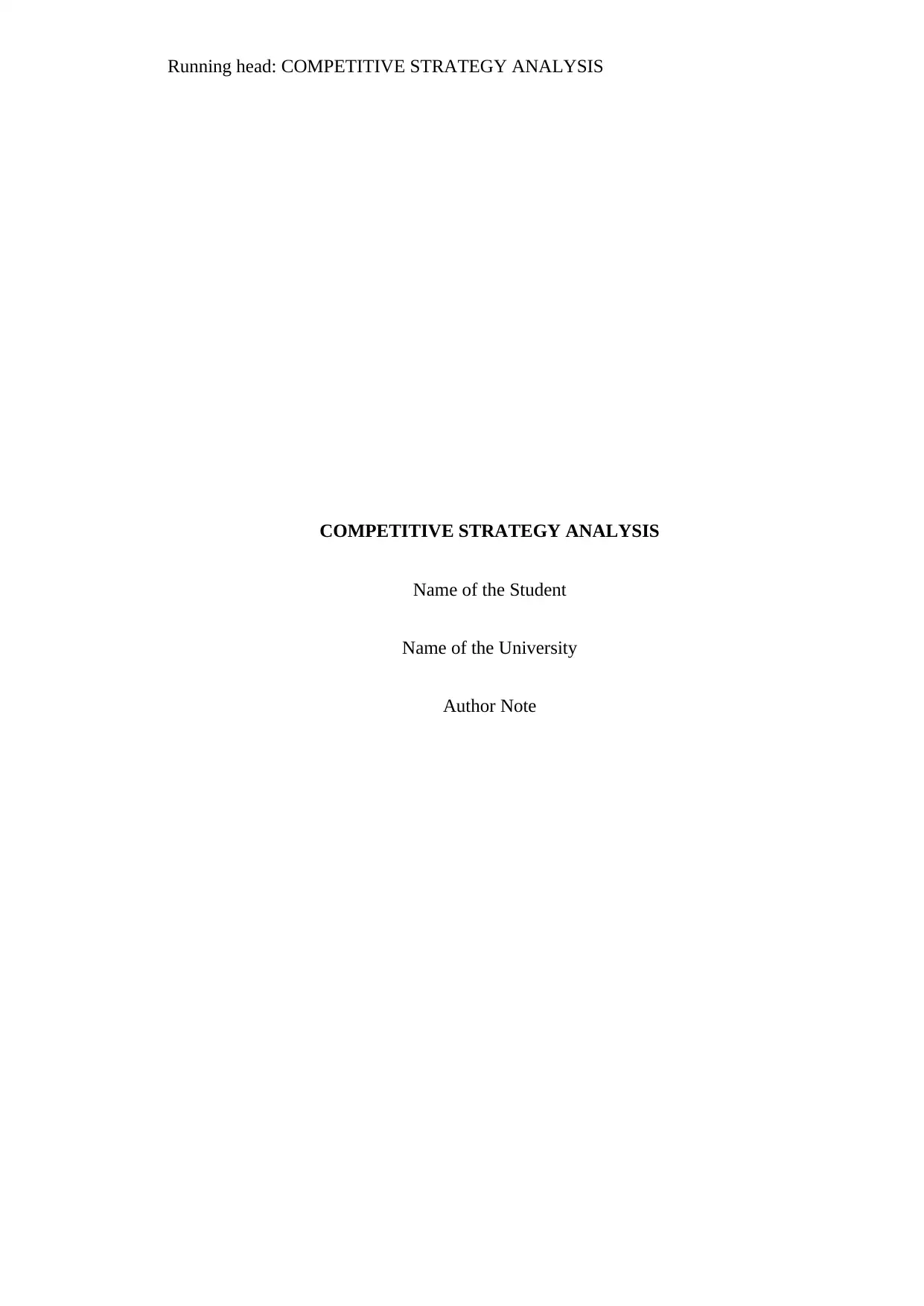
Running head: COMPETITIVE STRATEGY ANALYSIS
COMPETITIVE STRATEGY ANALYSIS
Name of the Student
Name of the University
Author Note
COMPETITIVE STRATEGY ANALYSIS
Name of the Student
Name of the University
Author Note
Paraphrase This Document
Need a fresh take? Get an instant paraphrase of this document with our AI Paraphraser
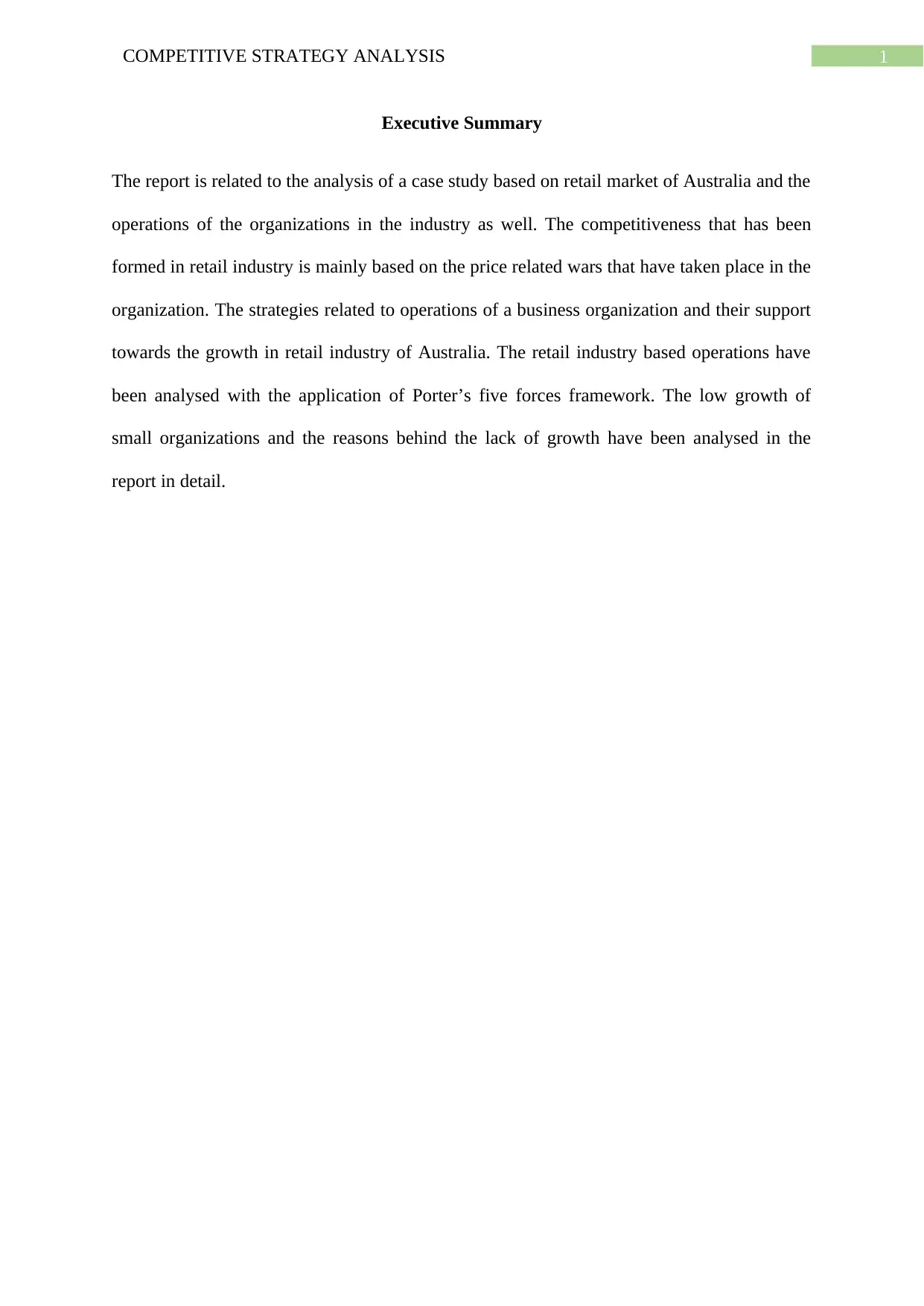
1COMPETITIVE STRATEGY ANALYSIS
Executive Summary
The report is related to the analysis of a case study based on retail market of Australia and the
operations of the organizations in the industry as well. The competitiveness that has been
formed in retail industry is mainly based on the price related wars that have taken place in the
organization. The strategies related to operations of a business organization and their support
towards the growth in retail industry of Australia. The retail industry based operations have
been analysed with the application of Porter’s five forces framework. The low growth of
small organizations and the reasons behind the lack of growth have been analysed in the
report in detail.
Executive Summary
The report is related to the analysis of a case study based on retail market of Australia and the
operations of the organizations in the industry as well. The competitiveness that has been
formed in retail industry is mainly based on the price related wars that have taken place in the
organization. The strategies related to operations of a business organization and their support
towards the growth in retail industry of Australia. The retail industry based operations have
been analysed with the application of Porter’s five forces framework. The low growth of
small organizations and the reasons behind the lack of growth have been analysed in the
report in detail.
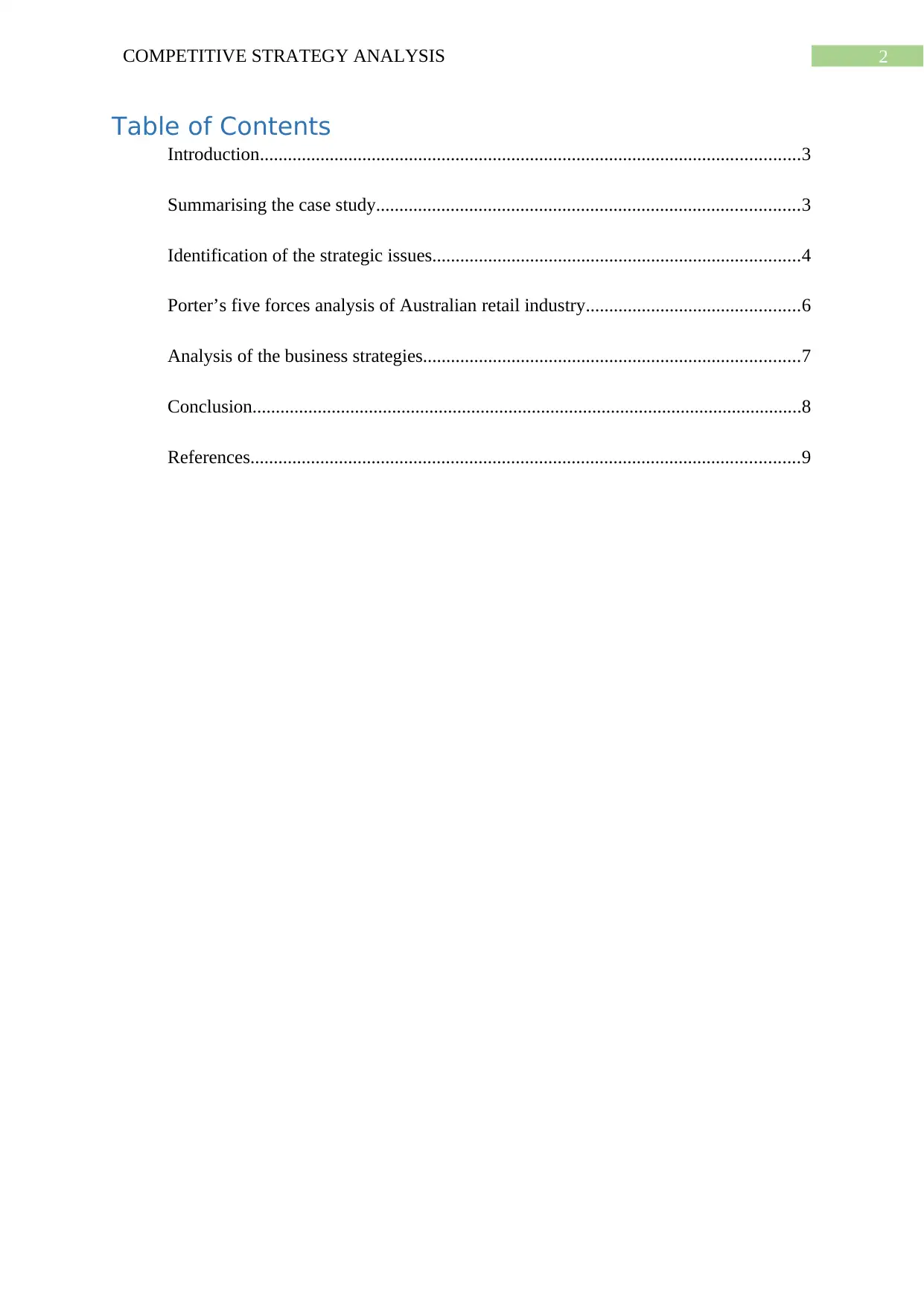
2COMPETITIVE STRATEGY ANALYSIS
Table of Contents
Introduction....................................................................................................................3
Summarising the case study...........................................................................................3
Identification of the strategic issues...............................................................................4
Porter’s five forces analysis of Australian retail industry..............................................6
Analysis of the business strategies.................................................................................7
Conclusion......................................................................................................................8
References......................................................................................................................9
Table of Contents
Introduction....................................................................................................................3
Summarising the case study...........................................................................................3
Identification of the strategic issues...............................................................................4
Porter’s five forces analysis of Australian retail industry..............................................6
Analysis of the business strategies.................................................................................7
Conclusion......................................................................................................................8
References......................................................................................................................9
⊘ This is a preview!⊘
Do you want full access?
Subscribe today to unlock all pages.

Trusted by 1+ million students worldwide
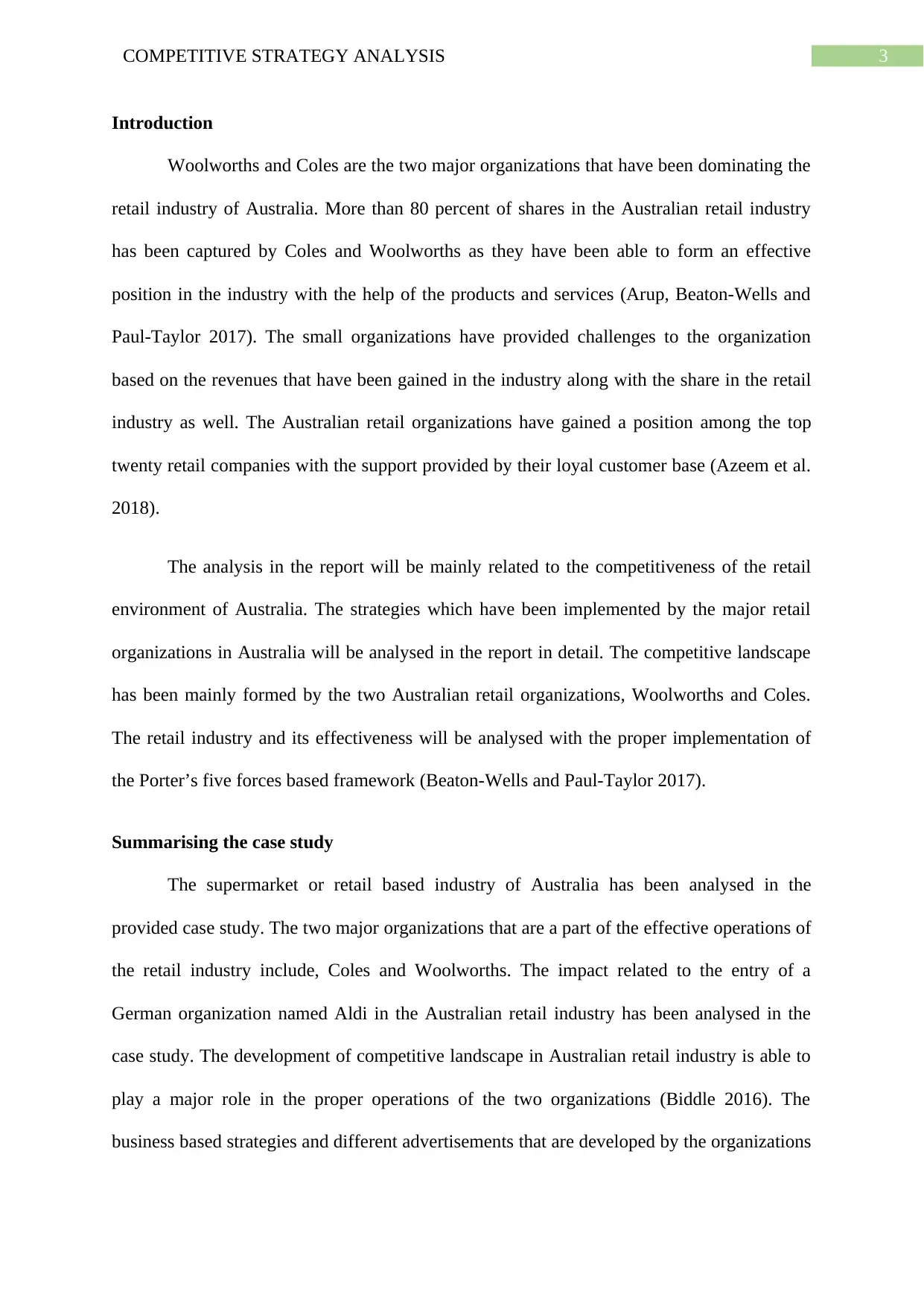
3COMPETITIVE STRATEGY ANALYSIS
Introduction
Woolworths and Coles are the two major organizations that have been dominating the
retail industry of Australia. More than 80 percent of shares in the Australian retail industry
has been captured by Coles and Woolworths as they have been able to form an effective
position in the industry with the help of the products and services (Arup, Beaton-Wells and
Paul-Taylor 2017). The small organizations have provided challenges to the organization
based on the revenues that have been gained in the industry along with the share in the retail
industry as well. The Australian retail organizations have gained a position among the top
twenty retail companies with the support provided by their loyal customer base (Azeem et al.
2018).
The analysis in the report will be mainly related to the competitiveness of the retail
environment of Australia. The strategies which have been implemented by the major retail
organizations in Australia will be analysed in the report in detail. The competitive landscape
has been mainly formed by the two Australian retail organizations, Woolworths and Coles.
The retail industry and its effectiveness will be analysed with the proper implementation of
the Porter’s five forces based framework (Beaton-Wells and Paul-Taylor 2017).
Summarising the case study
The supermarket or retail based industry of Australia has been analysed in the
provided case study. The two major organizations that are a part of the effective operations of
the retail industry include, Coles and Woolworths. The impact related to the entry of a
German organization named Aldi in the Australian retail industry has been analysed in the
case study. The development of competitive landscape in Australian retail industry is able to
play a major role in the proper operations of the two organizations (Biddle 2016). The
business based strategies and different advertisements that are developed by the organizations
Introduction
Woolworths and Coles are the two major organizations that have been dominating the
retail industry of Australia. More than 80 percent of shares in the Australian retail industry
has been captured by Coles and Woolworths as they have been able to form an effective
position in the industry with the help of the products and services (Arup, Beaton-Wells and
Paul-Taylor 2017). The small organizations have provided challenges to the organization
based on the revenues that have been gained in the industry along with the share in the retail
industry as well. The Australian retail organizations have gained a position among the top
twenty retail companies with the support provided by their loyal customer base (Azeem et al.
2018).
The analysis in the report will be mainly related to the competitiveness of the retail
environment of Australia. The strategies which have been implemented by the major retail
organizations in Australia will be analysed in the report in detail. The competitive landscape
has been mainly formed by the two Australian retail organizations, Woolworths and Coles.
The retail industry and its effectiveness will be analysed with the proper implementation of
the Porter’s five forces based framework (Beaton-Wells and Paul-Taylor 2017).
Summarising the case study
The supermarket or retail based industry of Australia has been analysed in the
provided case study. The two major organizations that are a part of the effective operations of
the retail industry include, Coles and Woolworths. The impact related to the entry of a
German organization named Aldi in the Australian retail industry has been analysed in the
case study. The development of competitive landscape in Australian retail industry is able to
play a major role in the proper operations of the two organizations (Biddle 2016). The
business based strategies and different advertisements that are developed by the organizations
Paraphrase This Document
Need a fresh take? Get an instant paraphrase of this document with our AI Paraphraser
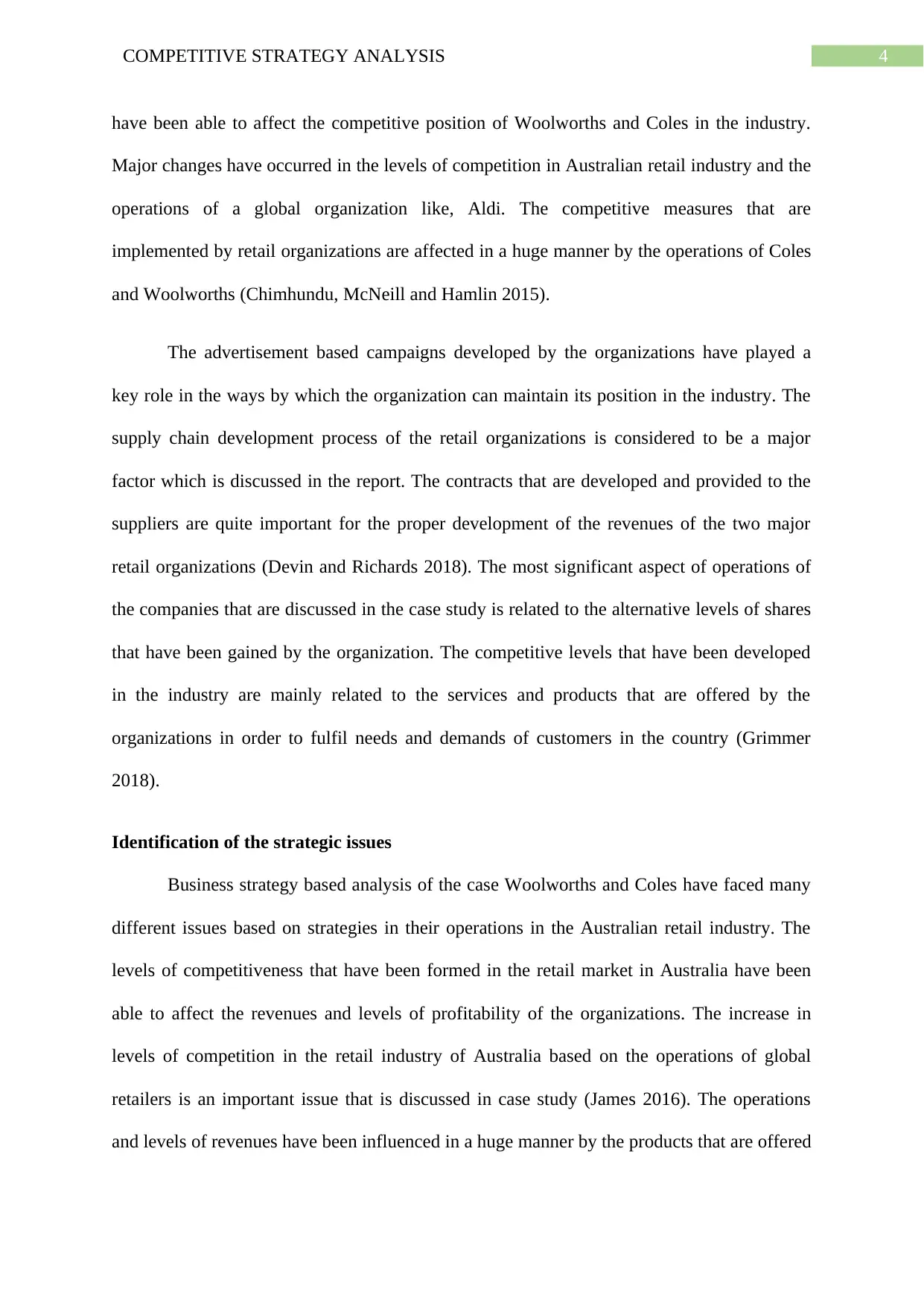
4COMPETITIVE STRATEGY ANALYSIS
have been able to affect the competitive position of Woolworths and Coles in the industry.
Major changes have occurred in the levels of competition in Australian retail industry and the
operations of a global organization like, Aldi. The competitive measures that are
implemented by retail organizations are affected in a huge manner by the operations of Coles
and Woolworths (Chimhundu, McNeill and Hamlin 2015).
The advertisement based campaigns developed by the organizations have played a
key role in the ways by which the organization can maintain its position in the industry. The
supply chain development process of the retail organizations is considered to be a major
factor which is discussed in the report. The contracts that are developed and provided to the
suppliers are quite important for the proper development of the revenues of the two major
retail organizations (Devin and Richards 2018). The most significant aspect of operations of
the companies that are discussed in the case study is related to the alternative levels of shares
that have been gained by the organization. The competitive levels that have been developed
in the industry are mainly related to the services and products that are offered by the
organizations in order to fulfil needs and demands of customers in the country (Grimmer
2018).
Identification of the strategic issues
Business strategy based analysis of the case Woolworths and Coles have faced many
different issues based on strategies in their operations in the Australian retail industry. The
levels of competitiveness that have been formed in the retail market in Australia have been
able to affect the revenues and levels of profitability of the organizations. The increase in
levels of competition in the retail industry of Australia based on the operations of global
retailers is an important issue that is discussed in case study (James 2016). The operations
and levels of revenues have been influenced in a huge manner by the products that are offered
have been able to affect the competitive position of Woolworths and Coles in the industry.
Major changes have occurred in the levels of competition in Australian retail industry and the
operations of a global organization like, Aldi. The competitive measures that are
implemented by retail organizations are affected in a huge manner by the operations of Coles
and Woolworths (Chimhundu, McNeill and Hamlin 2015).
The advertisement based campaigns developed by the organizations have played a
key role in the ways by which the organization can maintain its position in the industry. The
supply chain development process of the retail organizations is considered to be a major
factor which is discussed in the report. The contracts that are developed and provided to the
suppliers are quite important for the proper development of the revenues of the two major
retail organizations (Devin and Richards 2018). The most significant aspect of operations of
the companies that are discussed in the case study is related to the alternative levels of shares
that have been gained by the organization. The competitive levels that have been developed
in the industry are mainly related to the services and products that are offered by the
organizations in order to fulfil needs and demands of customers in the country (Grimmer
2018).
Identification of the strategic issues
Business strategy based analysis of the case Woolworths and Coles have faced many
different issues based on strategies in their operations in the Australian retail industry. The
levels of competitiveness that have been formed in the retail market in Australia have been
able to affect the revenues and levels of profitability of the organizations. The increase in
levels of competition in the retail industry of Australia based on the operations of global
retailers is an important issue that is discussed in case study (James 2016). The operations
and levels of revenues have been influenced in a huge manner by the products that are offered
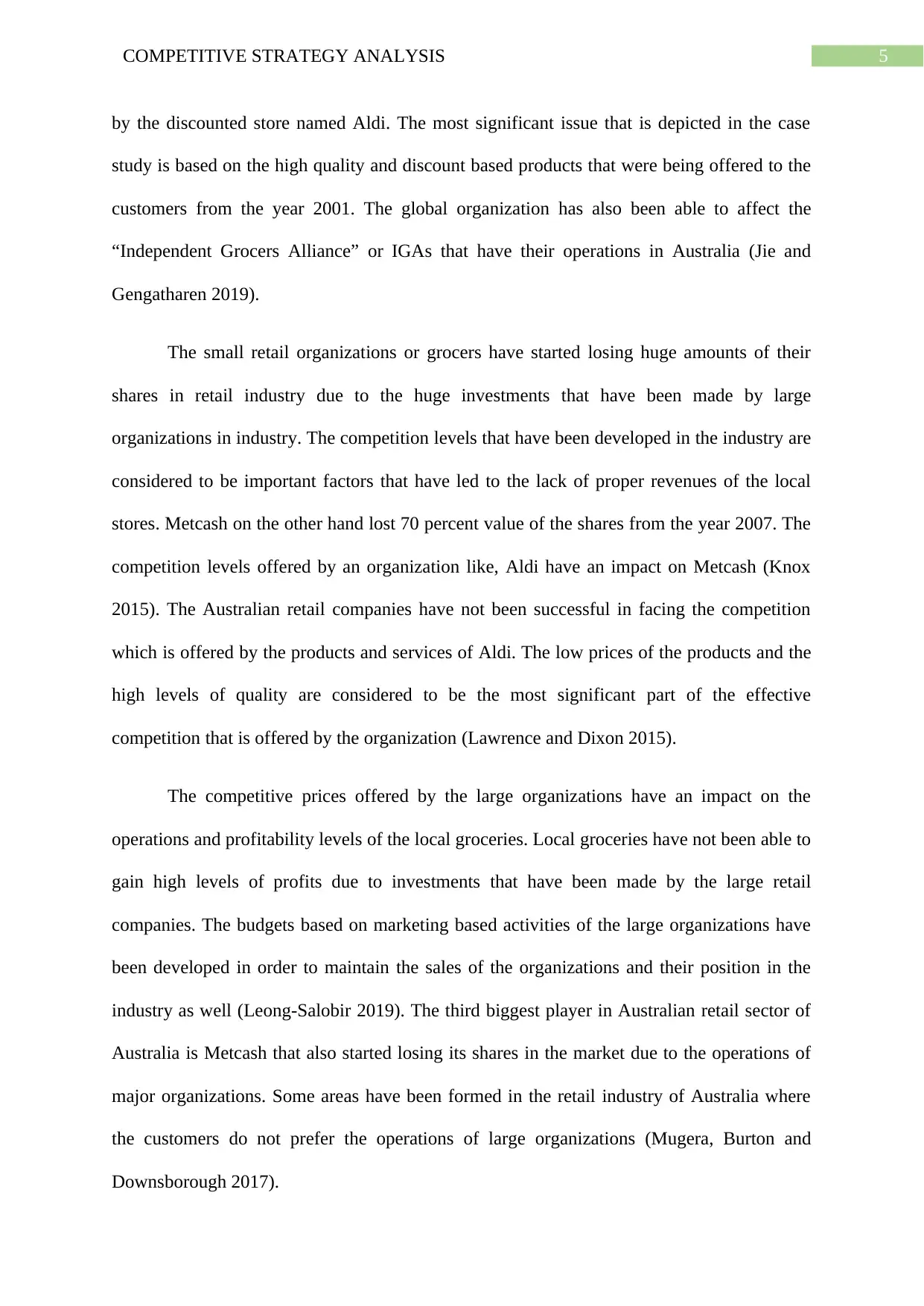
5COMPETITIVE STRATEGY ANALYSIS
by the discounted store named Aldi. The most significant issue that is depicted in the case
study is based on the high quality and discount based products that were being offered to the
customers from the year 2001. The global organization has also been able to affect the
“Independent Grocers Alliance” or IGAs that have their operations in Australia (Jie and
Gengatharen 2019).
The small retail organizations or grocers have started losing huge amounts of their
shares in retail industry due to the huge investments that have been made by large
organizations in industry. The competition levels that have been developed in the industry are
considered to be important factors that have led to the lack of proper revenues of the local
stores. Metcash on the other hand lost 70 percent value of the shares from the year 2007. The
competition levels offered by an organization like, Aldi have an impact on Metcash (Knox
2015). The Australian retail companies have not been successful in facing the competition
which is offered by the products and services of Aldi. The low prices of the products and the
high levels of quality are considered to be the most significant part of the effective
competition that is offered by the organization (Lawrence and Dixon 2015).
The competitive prices offered by the large organizations have an impact on the
operations and profitability levels of the local groceries. Local groceries have not been able to
gain high levels of profits due to investments that have been made by the large retail
companies. The budgets based on marketing based activities of the large organizations have
been developed in order to maintain the sales of the organizations and their position in the
industry as well (Leong-Salobir 2019). The third biggest player in Australian retail sector of
Australia is Metcash that also started losing its shares in the market due to the operations of
major organizations. Some areas have been formed in the retail industry of Australia where
the customers do not prefer the operations of large organizations (Mugera, Burton and
Downsborough 2017).
by the discounted store named Aldi. The most significant issue that is depicted in the case
study is based on the high quality and discount based products that were being offered to the
customers from the year 2001. The global organization has also been able to affect the
“Independent Grocers Alliance” or IGAs that have their operations in Australia (Jie and
Gengatharen 2019).
The small retail organizations or grocers have started losing huge amounts of their
shares in retail industry due to the huge investments that have been made by large
organizations in industry. The competition levels that have been developed in the industry are
considered to be important factors that have led to the lack of proper revenues of the local
stores. Metcash on the other hand lost 70 percent value of the shares from the year 2007. The
competition levels offered by an organization like, Aldi have an impact on Metcash (Knox
2015). The Australian retail companies have not been successful in facing the competition
which is offered by the products and services of Aldi. The low prices of the products and the
high levels of quality are considered to be the most significant part of the effective
competition that is offered by the organization (Lawrence and Dixon 2015).
The competitive prices offered by the large organizations have an impact on the
operations and profitability levels of the local groceries. Local groceries have not been able to
gain high levels of profits due to investments that have been made by the large retail
companies. The budgets based on marketing based activities of the large organizations have
been developed in order to maintain the sales of the organizations and their position in the
industry as well (Leong-Salobir 2019). The third biggest player in Australian retail sector of
Australia is Metcash that also started losing its shares in the market due to the operations of
major organizations. Some areas have been formed in the retail industry of Australia where
the customers do not prefer the operations of large organizations (Mugera, Burton and
Downsborough 2017).
⊘ This is a preview!⊘
Do you want full access?
Subscribe today to unlock all pages.

Trusted by 1+ million students worldwide
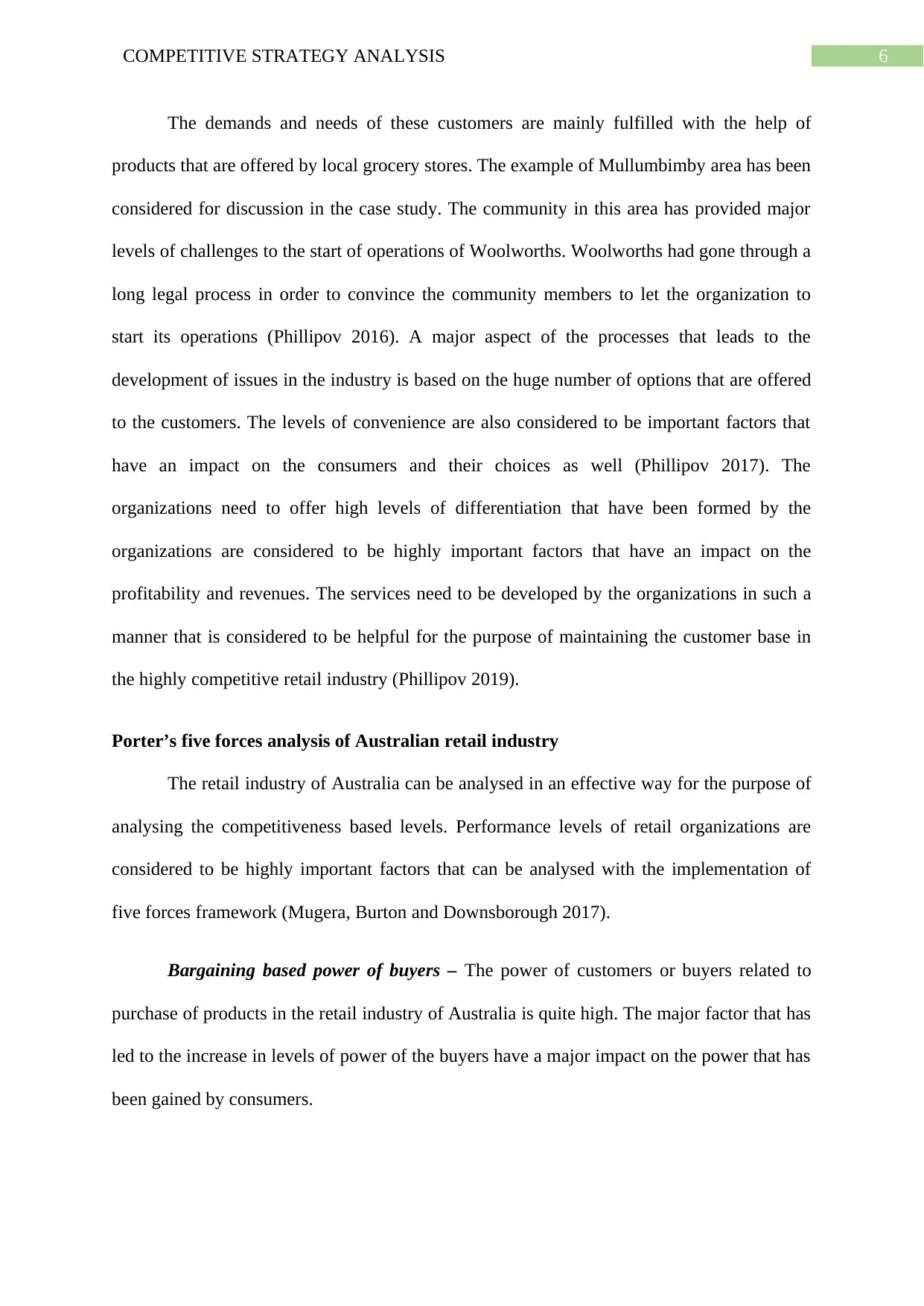
6COMPETITIVE STRATEGY ANALYSIS
The demands and needs of these customers are mainly fulfilled with the help of
products that are offered by local grocery stores. The example of Mullumbimby area has been
considered for discussion in the case study. The community in this area has provided major
levels of challenges to the start of operations of Woolworths. Woolworths had gone through a
long legal process in order to convince the community members to let the organization to
start its operations (Phillipov 2016). A major aspect of the processes that leads to the
development of issues in the industry is based on the huge number of options that are offered
to the customers. The levels of convenience are also considered to be important factors that
have an impact on the consumers and their choices as well (Phillipov 2017). The
organizations need to offer high levels of differentiation that have been formed by the
organizations are considered to be highly important factors that have an impact on the
profitability and revenues. The services need to be developed by the organizations in such a
manner that is considered to be helpful for the purpose of maintaining the customer base in
the highly competitive retail industry (Phillipov 2019).
Porter’s five forces analysis of Australian retail industry
The retail industry of Australia can be analysed in an effective way for the purpose of
analysing the competitiveness based levels. Performance levels of retail organizations are
considered to be highly important factors that can be analysed with the implementation of
five forces framework (Mugera, Burton and Downsborough 2017).
Bargaining based power of buyers – The power of customers or buyers related to
purchase of products in the retail industry of Australia is quite high. The major factor that has
led to the increase in levels of power of the buyers have a major impact on the power that has
been gained by consumers.
The demands and needs of these customers are mainly fulfilled with the help of
products that are offered by local grocery stores. The example of Mullumbimby area has been
considered for discussion in the case study. The community in this area has provided major
levels of challenges to the start of operations of Woolworths. Woolworths had gone through a
long legal process in order to convince the community members to let the organization to
start its operations (Phillipov 2016). A major aspect of the processes that leads to the
development of issues in the industry is based on the huge number of options that are offered
to the customers. The levels of convenience are also considered to be important factors that
have an impact on the consumers and their choices as well (Phillipov 2017). The
organizations need to offer high levels of differentiation that have been formed by the
organizations are considered to be highly important factors that have an impact on the
profitability and revenues. The services need to be developed by the organizations in such a
manner that is considered to be helpful for the purpose of maintaining the customer base in
the highly competitive retail industry (Phillipov 2019).
Porter’s five forces analysis of Australian retail industry
The retail industry of Australia can be analysed in an effective way for the purpose of
analysing the competitiveness based levels. Performance levels of retail organizations are
considered to be highly important factors that can be analysed with the implementation of
five forces framework (Mugera, Burton and Downsborough 2017).
Bargaining based power of buyers – The power of customers or buyers related to
purchase of products in the retail industry of Australia is quite high. The major factor that has
led to the increase in levels of power of the buyers have a major impact on the power that has
been gained by consumers.
Paraphrase This Document
Need a fresh take? Get an instant paraphrase of this document with our AI Paraphraser
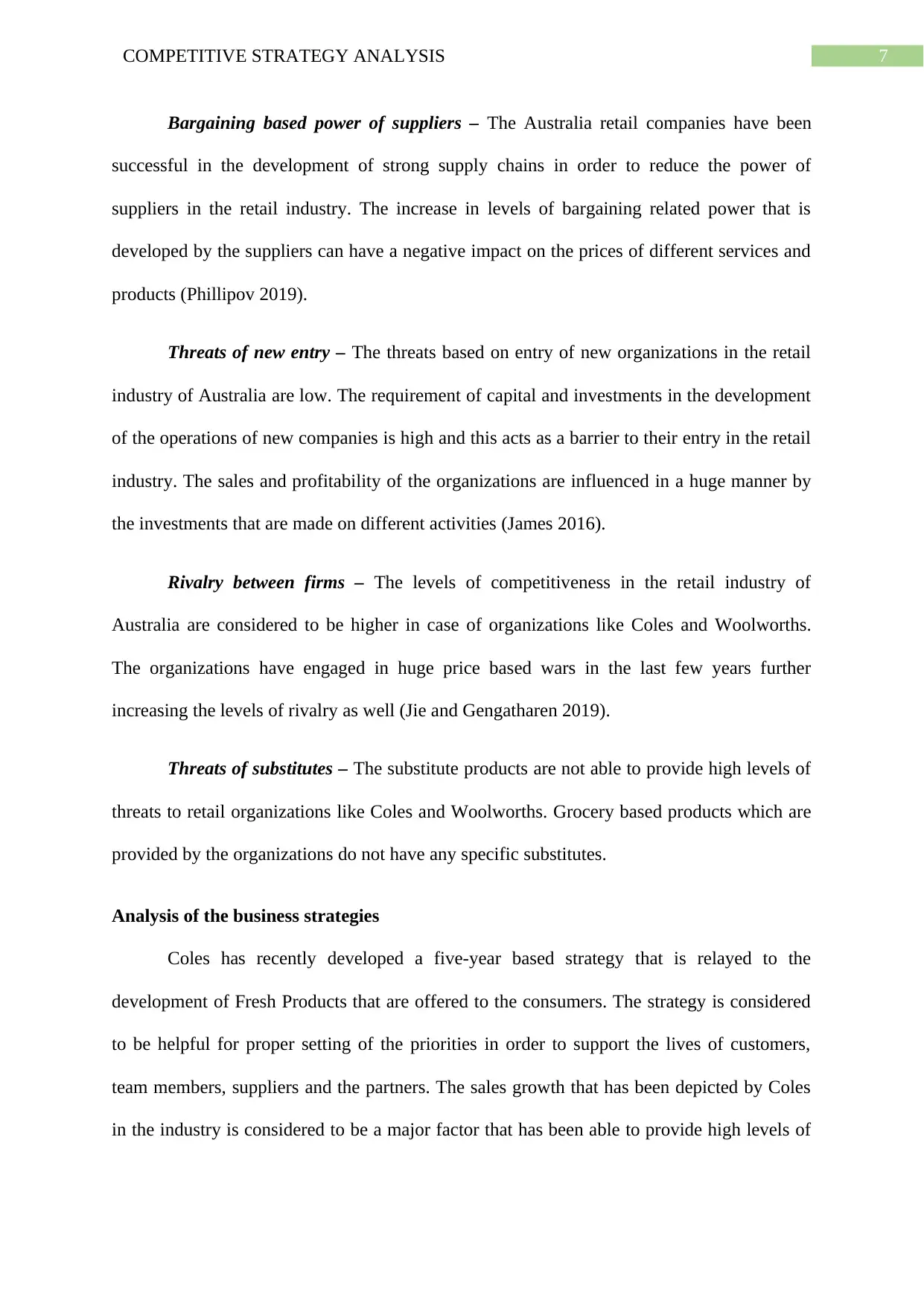
7COMPETITIVE STRATEGY ANALYSIS
Bargaining based power of suppliers – The Australia retail companies have been
successful in the development of strong supply chains in order to reduce the power of
suppliers in the retail industry. The increase in levels of bargaining related power that is
developed by the suppliers can have a negative impact on the prices of different services and
products (Phillipov 2019).
Threats of new entry – The threats based on entry of new organizations in the retail
industry of Australia are low. The requirement of capital and investments in the development
of the operations of new companies is high and this acts as a barrier to their entry in the retail
industry. The sales and profitability of the organizations are influenced in a huge manner by
the investments that are made on different activities (James 2016).
Rivalry between firms – The levels of competitiveness in the retail industry of
Australia are considered to be higher in case of organizations like Coles and Woolworths.
The organizations have engaged in huge price based wars in the last few years further
increasing the levels of rivalry as well (Jie and Gengatharen 2019).
Threats of substitutes – The substitute products are not able to provide high levels of
threats to retail organizations like Coles and Woolworths. Grocery based products which are
provided by the organizations do not have any specific substitutes.
Analysis of the business strategies
Coles has recently developed a five-year based strategy that is relayed to the
development of Fresh Products that are offered to the consumers. The strategy is considered
to be helpful for proper setting of the priorities in order to support the lives of customers,
team members, suppliers and the partners. The sales growth that has been depicted by Coles
in the industry is considered to be a major factor that has been able to provide high levels of
Bargaining based power of suppliers – The Australia retail companies have been
successful in the development of strong supply chains in order to reduce the power of
suppliers in the retail industry. The increase in levels of bargaining related power that is
developed by the suppliers can have a negative impact on the prices of different services and
products (Phillipov 2019).
Threats of new entry – The threats based on entry of new organizations in the retail
industry of Australia are low. The requirement of capital and investments in the development
of the operations of new companies is high and this acts as a barrier to their entry in the retail
industry. The sales and profitability of the organizations are influenced in a huge manner by
the investments that are made on different activities (James 2016).
Rivalry between firms – The levels of competitiveness in the retail industry of
Australia are considered to be higher in case of organizations like Coles and Woolworths.
The organizations have engaged in huge price based wars in the last few years further
increasing the levels of rivalry as well (Jie and Gengatharen 2019).
Threats of substitutes – The substitute products are not able to provide high levels of
threats to retail organizations like Coles and Woolworths. Grocery based products which are
provided by the organizations do not have any specific substitutes.
Analysis of the business strategies
Coles has recently developed a five-year based strategy that is relayed to the
development of Fresh Products that are offered to the consumers. The strategy is considered
to be helpful for proper setting of the priorities in order to support the lives of customers,
team members, suppliers and the partners. The sales growth that has been depicted by Coles
in the industry is considered to be a major factor that has been able to provide high levels of
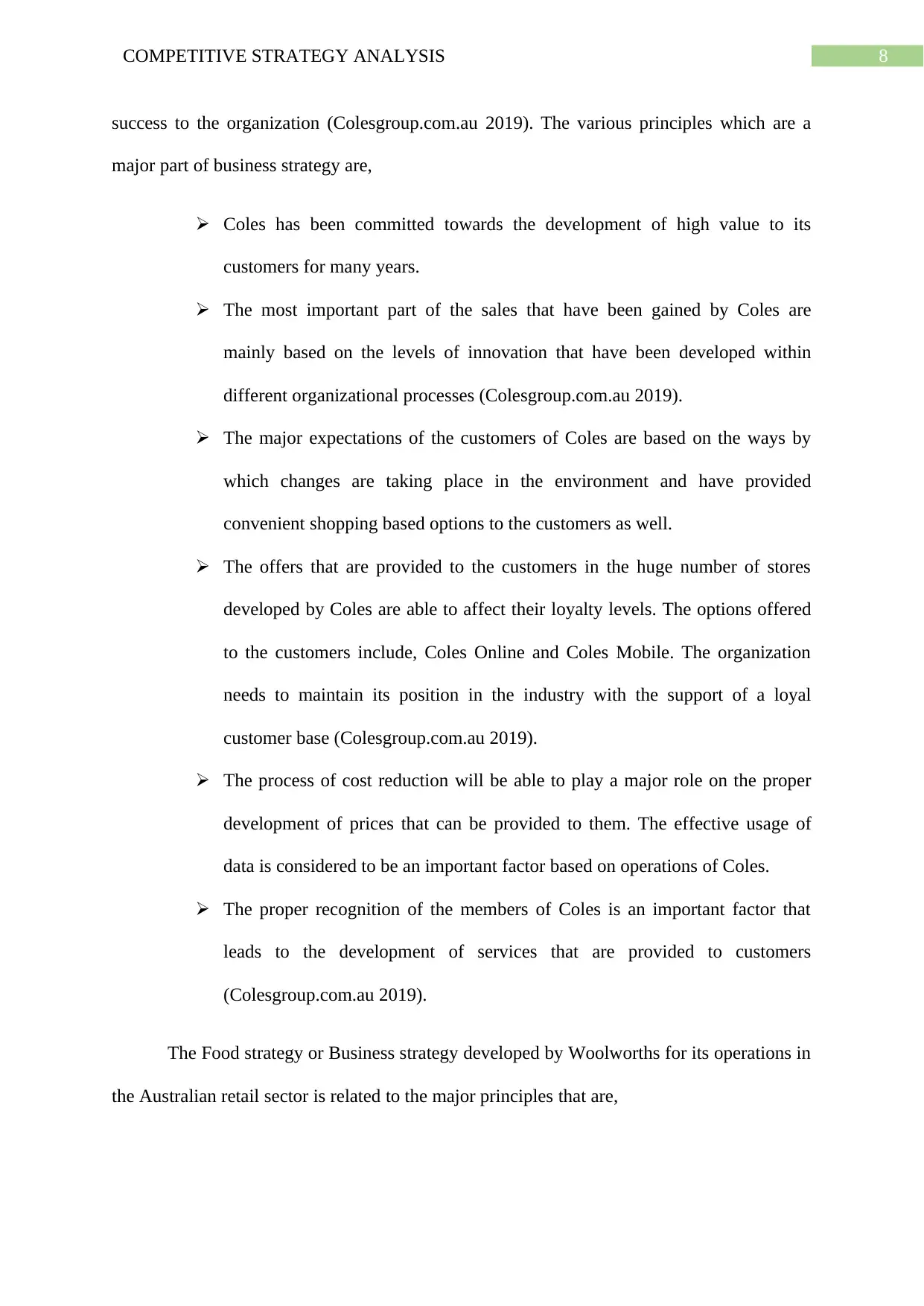
8COMPETITIVE STRATEGY ANALYSIS
success to the organization (Colesgroup.com.au 2019). The various principles which are a
major part of business strategy are,
Coles has been committed towards the development of high value to its
customers for many years.
The most important part of the sales that have been gained by Coles are
mainly based on the levels of innovation that have been developed within
different organizational processes (Colesgroup.com.au 2019).
The major expectations of the customers of Coles are based on the ways by
which changes are taking place in the environment and have provided
convenient shopping based options to the customers as well.
The offers that are provided to the customers in the huge number of stores
developed by Coles are able to affect their loyalty levels. The options offered
to the customers include, Coles Online and Coles Mobile. The organization
needs to maintain its position in the industry with the support of a loyal
customer base (Colesgroup.com.au 2019).
The process of cost reduction will be able to play a major role on the proper
development of prices that can be provided to them. The effective usage of
data is considered to be an important factor based on operations of Coles.
The proper recognition of the members of Coles is an important factor that
leads to the development of services that are provided to customers
(Colesgroup.com.au 2019).
The Food strategy or Business strategy developed by Woolworths for its operations in
the Australian retail sector is related to the major principles that are,
success to the organization (Colesgroup.com.au 2019). The various principles which are a
major part of business strategy are,
Coles has been committed towards the development of high value to its
customers for many years.
The most important part of the sales that have been gained by Coles are
mainly based on the levels of innovation that have been developed within
different organizational processes (Colesgroup.com.au 2019).
The major expectations of the customers of Coles are based on the ways by
which changes are taking place in the environment and have provided
convenient shopping based options to the customers as well.
The offers that are provided to the customers in the huge number of stores
developed by Coles are able to affect their loyalty levels. The options offered
to the customers include, Coles Online and Coles Mobile. The organization
needs to maintain its position in the industry with the support of a loyal
customer base (Colesgroup.com.au 2019).
The process of cost reduction will be able to play a major role on the proper
development of prices that can be provided to them. The effective usage of
data is considered to be an important factor based on operations of Coles.
The proper recognition of the members of Coles is an important factor that
leads to the development of services that are provided to customers
(Colesgroup.com.au 2019).
The Food strategy or Business strategy developed by Woolworths for its operations in
the Australian retail sector is related to the major principles that are,
⊘ This is a preview!⊘
Do you want full access?
Subscribe today to unlock all pages.

Trusted by 1+ million students worldwide
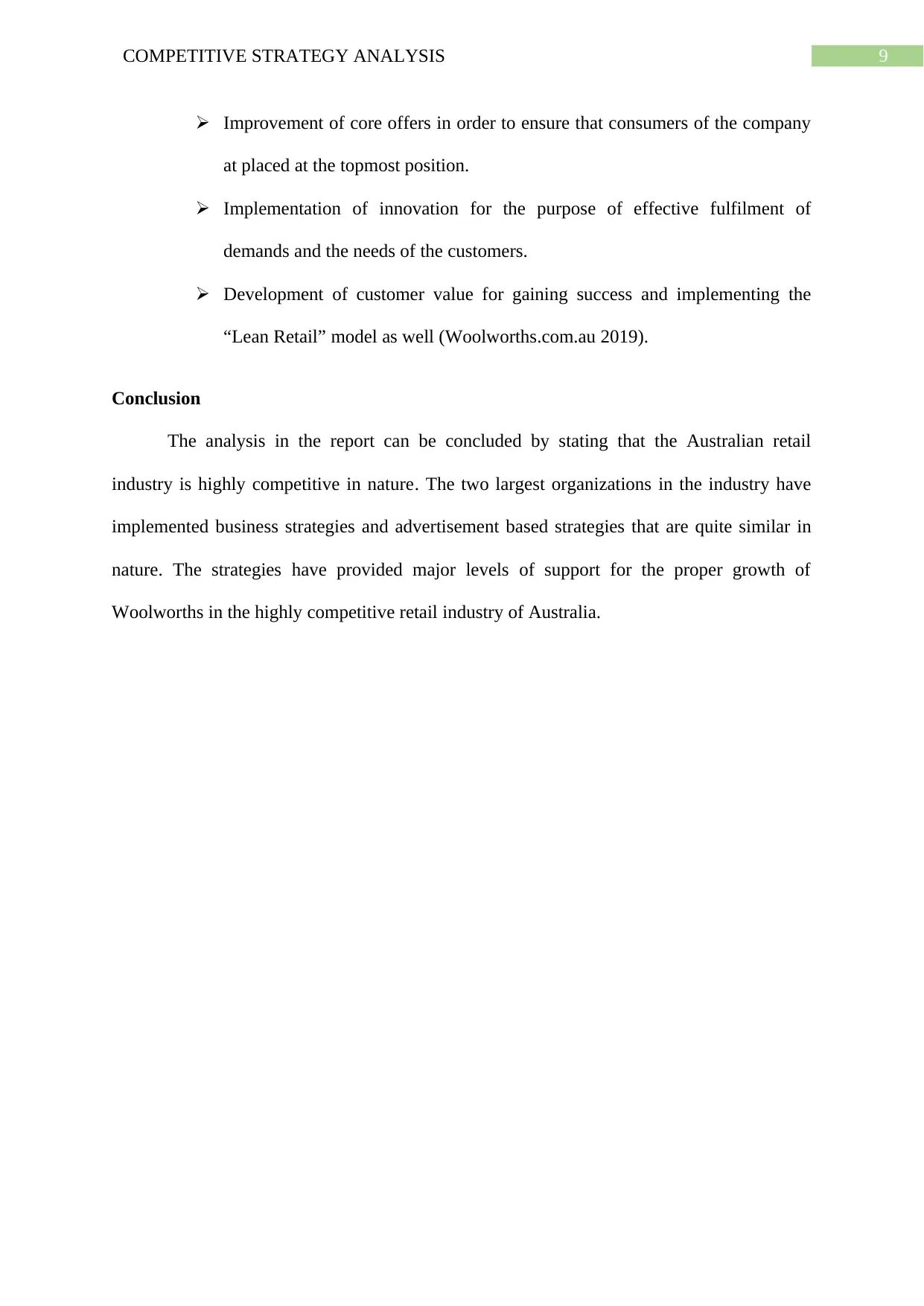
9COMPETITIVE STRATEGY ANALYSIS
Improvement of core offers in order to ensure that consumers of the company
at placed at the topmost position.
Implementation of innovation for the purpose of effective fulfilment of
demands and the needs of the customers.
Development of customer value for gaining success and implementing the
“Lean Retail” model as well (Woolworths.com.au 2019).
Conclusion
The analysis in the report can be concluded by stating that the Australian retail
industry is highly competitive in nature. The two largest organizations in the industry have
implemented business strategies and advertisement based strategies that are quite similar in
nature. The strategies have provided major levels of support for the proper growth of
Woolworths in the highly competitive retail industry of Australia.
Improvement of core offers in order to ensure that consumers of the company
at placed at the topmost position.
Implementation of innovation for the purpose of effective fulfilment of
demands and the needs of the customers.
Development of customer value for gaining success and implementing the
“Lean Retail” model as well (Woolworths.com.au 2019).
Conclusion
The analysis in the report can be concluded by stating that the Australian retail
industry is highly competitive in nature. The two largest organizations in the industry have
implemented business strategies and advertisement based strategies that are quite similar in
nature. The strategies have provided major levels of support for the proper growth of
Woolworths in the highly competitive retail industry of Australia.
Paraphrase This Document
Need a fresh take? Get an instant paraphrase of this document with our AI Paraphraser
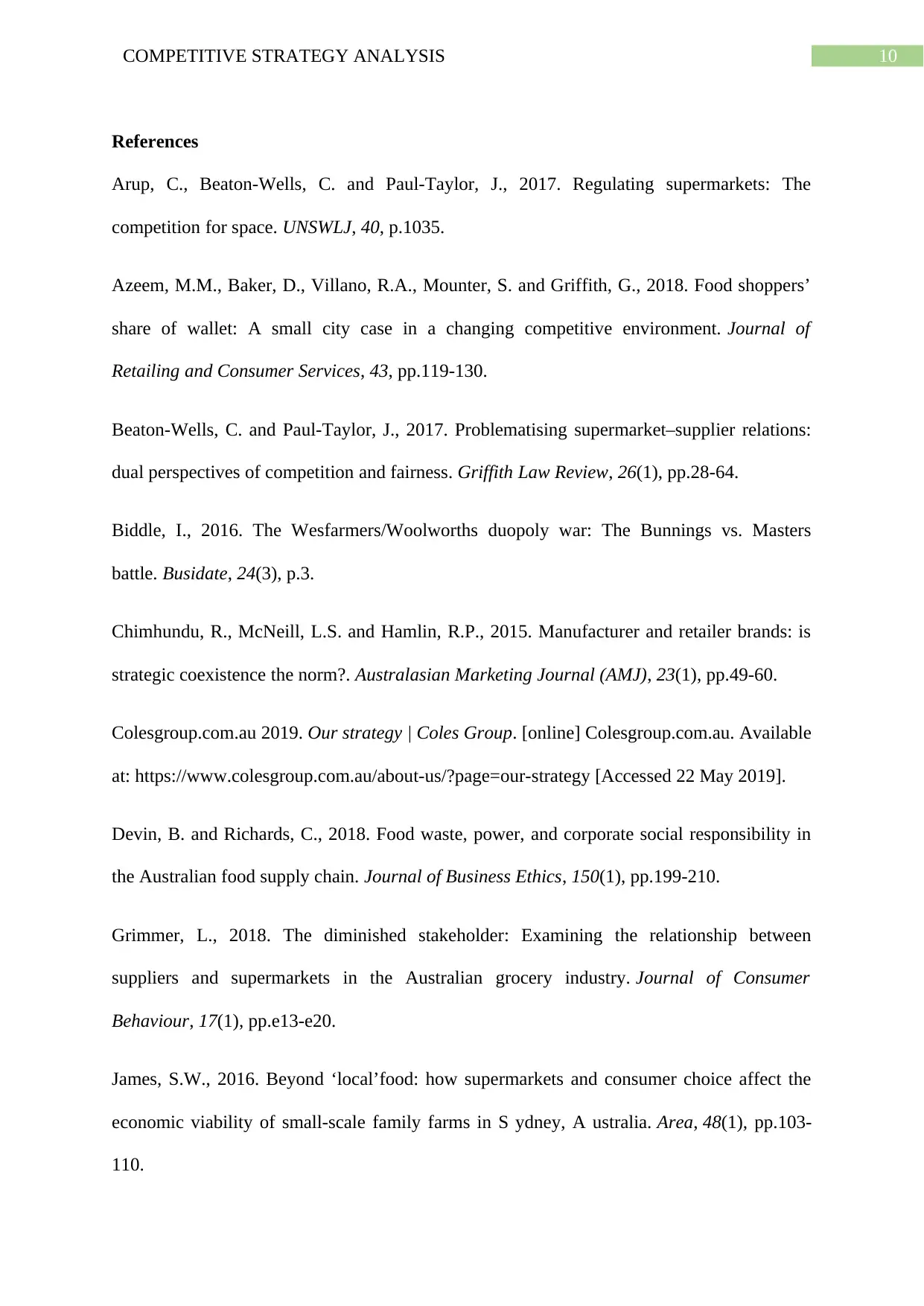
10COMPETITIVE STRATEGY ANALYSIS
References
Arup, C., Beaton-Wells, C. and Paul-Taylor, J., 2017. Regulating supermarkets: The
competition for space. UNSWLJ, 40, p.1035.
Azeem, M.M., Baker, D., Villano, R.A., Mounter, S. and Griffith, G., 2018. Food shoppers’
share of wallet: A small city case in a changing competitive environment. Journal of
Retailing and Consumer Services, 43, pp.119-130.
Beaton-Wells, C. and Paul-Taylor, J., 2017. Problematising supermarket–supplier relations:
dual perspectives of competition and fairness. Griffith Law Review, 26(1), pp.28-64.
Biddle, I., 2016. The Wesfarmers/Woolworths duopoly war: The Bunnings vs. Masters
battle. Busidate, 24(3), p.3.
Chimhundu, R., McNeill, L.S. and Hamlin, R.P., 2015. Manufacturer and retailer brands: is
strategic coexistence the norm?. Australasian Marketing Journal (AMJ), 23(1), pp.49-60.
Colesgroup.com.au 2019. Our strategy | Coles Group. [online] Colesgroup.com.au. Available
at: https://www.colesgroup.com.au/about-us/?page=our-strategy [Accessed 22 May 2019].
Devin, B. and Richards, C., 2018. Food waste, power, and corporate social responsibility in
the Australian food supply chain. Journal of Business Ethics, 150(1), pp.199-210.
Grimmer, L., 2018. The diminished stakeholder: Examining the relationship between
suppliers and supermarkets in the Australian grocery industry. Journal of Consumer
Behaviour, 17(1), pp.e13-e20.
James, S.W., 2016. Beyond ‘local’food: how supermarkets and consumer choice affect the
economic viability of small‐scale family farms in S ydney, A ustralia. Area, 48(1), pp.103-
110.
References
Arup, C., Beaton-Wells, C. and Paul-Taylor, J., 2017. Regulating supermarkets: The
competition for space. UNSWLJ, 40, p.1035.
Azeem, M.M., Baker, D., Villano, R.A., Mounter, S. and Griffith, G., 2018. Food shoppers’
share of wallet: A small city case in a changing competitive environment. Journal of
Retailing and Consumer Services, 43, pp.119-130.
Beaton-Wells, C. and Paul-Taylor, J., 2017. Problematising supermarket–supplier relations:
dual perspectives of competition and fairness. Griffith Law Review, 26(1), pp.28-64.
Biddle, I., 2016. The Wesfarmers/Woolworths duopoly war: The Bunnings vs. Masters
battle. Busidate, 24(3), p.3.
Chimhundu, R., McNeill, L.S. and Hamlin, R.P., 2015. Manufacturer and retailer brands: is
strategic coexistence the norm?. Australasian Marketing Journal (AMJ), 23(1), pp.49-60.
Colesgroup.com.au 2019. Our strategy | Coles Group. [online] Colesgroup.com.au. Available
at: https://www.colesgroup.com.au/about-us/?page=our-strategy [Accessed 22 May 2019].
Devin, B. and Richards, C., 2018. Food waste, power, and corporate social responsibility in
the Australian food supply chain. Journal of Business Ethics, 150(1), pp.199-210.
Grimmer, L., 2018. The diminished stakeholder: Examining the relationship between
suppliers and supermarkets in the Australian grocery industry. Journal of Consumer
Behaviour, 17(1), pp.e13-e20.
James, S.W., 2016. Beyond ‘local’food: how supermarkets and consumer choice affect the
economic viability of small‐scale family farms in S ydney, A ustralia. Area, 48(1), pp.103-
110.
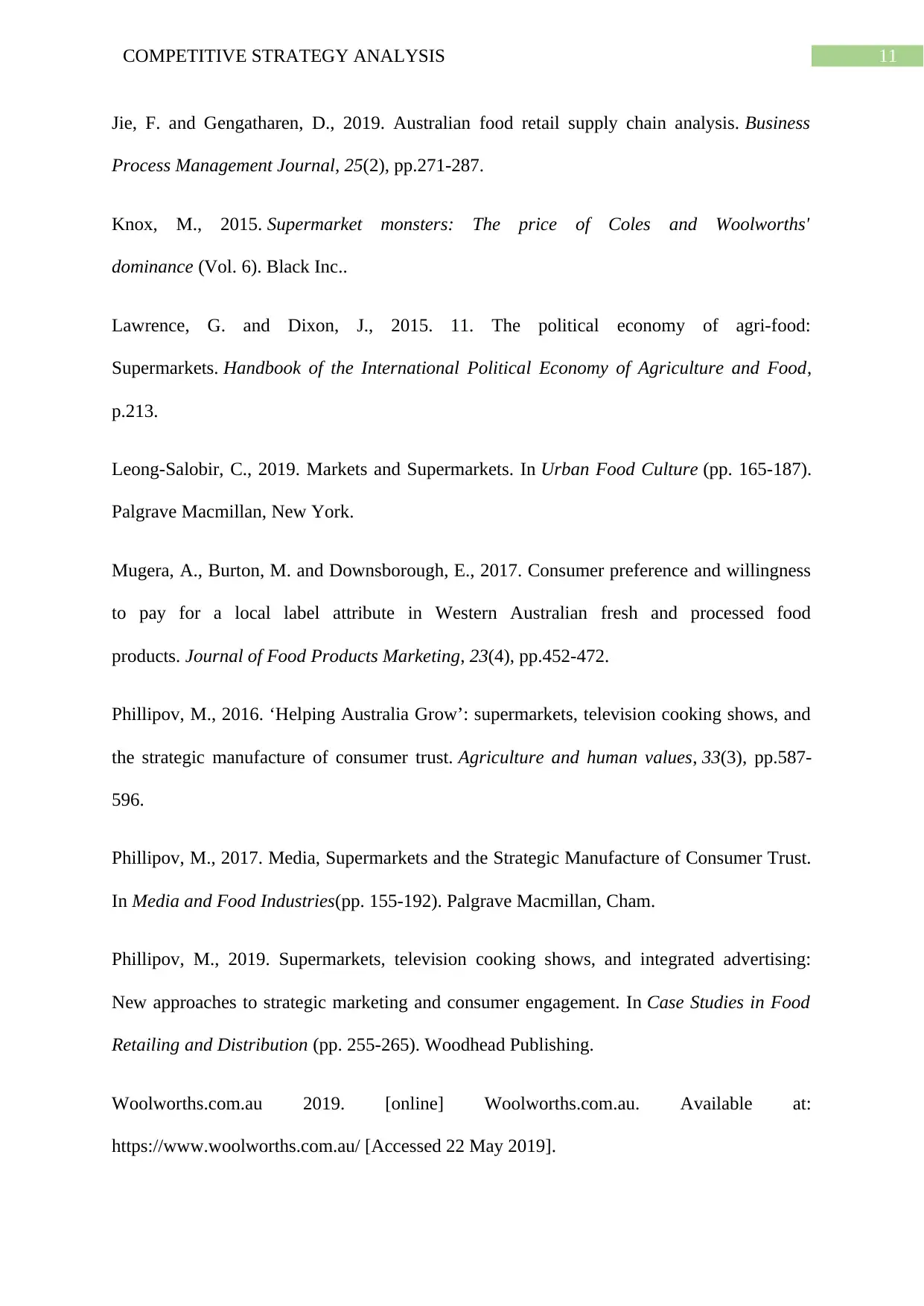
11COMPETITIVE STRATEGY ANALYSIS
Jie, F. and Gengatharen, D., 2019. Australian food retail supply chain analysis. Business
Process Management Journal, 25(2), pp.271-287.
Knox, M., 2015. Supermarket monsters: The price of Coles and Woolworths'
dominance (Vol. 6). Black Inc..
Lawrence, G. and Dixon, J., 2015. 11. The political economy of agri-food:
Supermarkets. Handbook of the International Political Economy of Agriculture and Food,
p.213.
Leong-Salobir, C., 2019. Markets and Supermarkets. In Urban Food Culture (pp. 165-187).
Palgrave Macmillan, New York.
Mugera, A., Burton, M. and Downsborough, E., 2017. Consumer preference and willingness
to pay for a local label attribute in Western Australian fresh and processed food
products. Journal of Food Products Marketing, 23(4), pp.452-472.
Phillipov, M., 2016. ‘Helping Australia Grow’: supermarkets, television cooking shows, and
the strategic manufacture of consumer trust. Agriculture and human values, 33(3), pp.587-
596.
Phillipov, M., 2017. Media, Supermarkets and the Strategic Manufacture of Consumer Trust.
In Media and Food Industries(pp. 155-192). Palgrave Macmillan, Cham.
Phillipov, M., 2019. Supermarkets, television cooking shows, and integrated advertising:
New approaches to strategic marketing and consumer engagement. In Case Studies in Food
Retailing and Distribution (pp. 255-265). Woodhead Publishing.
Woolworths.com.au 2019. [online] Woolworths.com.au. Available at:
https://www.woolworths.com.au/ [Accessed 22 May 2019].
Jie, F. and Gengatharen, D., 2019. Australian food retail supply chain analysis. Business
Process Management Journal, 25(2), pp.271-287.
Knox, M., 2015. Supermarket monsters: The price of Coles and Woolworths'
dominance (Vol. 6). Black Inc..
Lawrence, G. and Dixon, J., 2015. 11. The political economy of agri-food:
Supermarkets. Handbook of the International Political Economy of Agriculture and Food,
p.213.
Leong-Salobir, C., 2019. Markets and Supermarkets. In Urban Food Culture (pp. 165-187).
Palgrave Macmillan, New York.
Mugera, A., Burton, M. and Downsborough, E., 2017. Consumer preference and willingness
to pay for a local label attribute in Western Australian fresh and processed food
products. Journal of Food Products Marketing, 23(4), pp.452-472.
Phillipov, M., 2016. ‘Helping Australia Grow’: supermarkets, television cooking shows, and
the strategic manufacture of consumer trust. Agriculture and human values, 33(3), pp.587-
596.
Phillipov, M., 2017. Media, Supermarkets and the Strategic Manufacture of Consumer Trust.
In Media and Food Industries(pp. 155-192). Palgrave Macmillan, Cham.
Phillipov, M., 2019. Supermarkets, television cooking shows, and integrated advertising:
New approaches to strategic marketing and consumer engagement. In Case Studies in Food
Retailing and Distribution (pp. 255-265). Woodhead Publishing.
Woolworths.com.au 2019. [online] Woolworths.com.au. Available at:
https://www.woolworths.com.au/ [Accessed 22 May 2019].
⊘ This is a preview!⊘
Do you want full access?
Subscribe today to unlock all pages.

Trusted by 1+ million students worldwide
1 out of 13
Related Documents
Your All-in-One AI-Powered Toolkit for Academic Success.
+13062052269
info@desklib.com
Available 24*7 on WhatsApp / Email
![[object Object]](/_next/static/media/star-bottom.7253800d.svg)
Unlock your academic potential
Copyright © 2020–2025 A2Z Services. All Rights Reserved. Developed and managed by ZUCOL.




